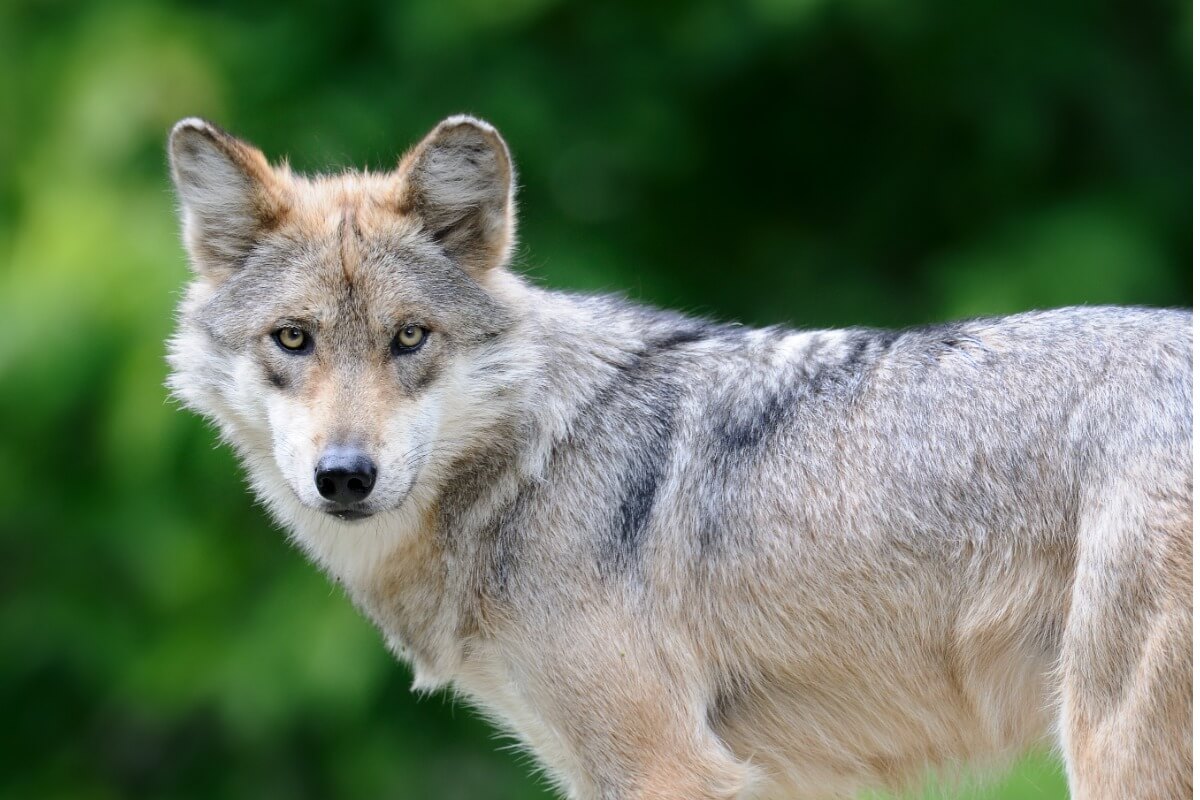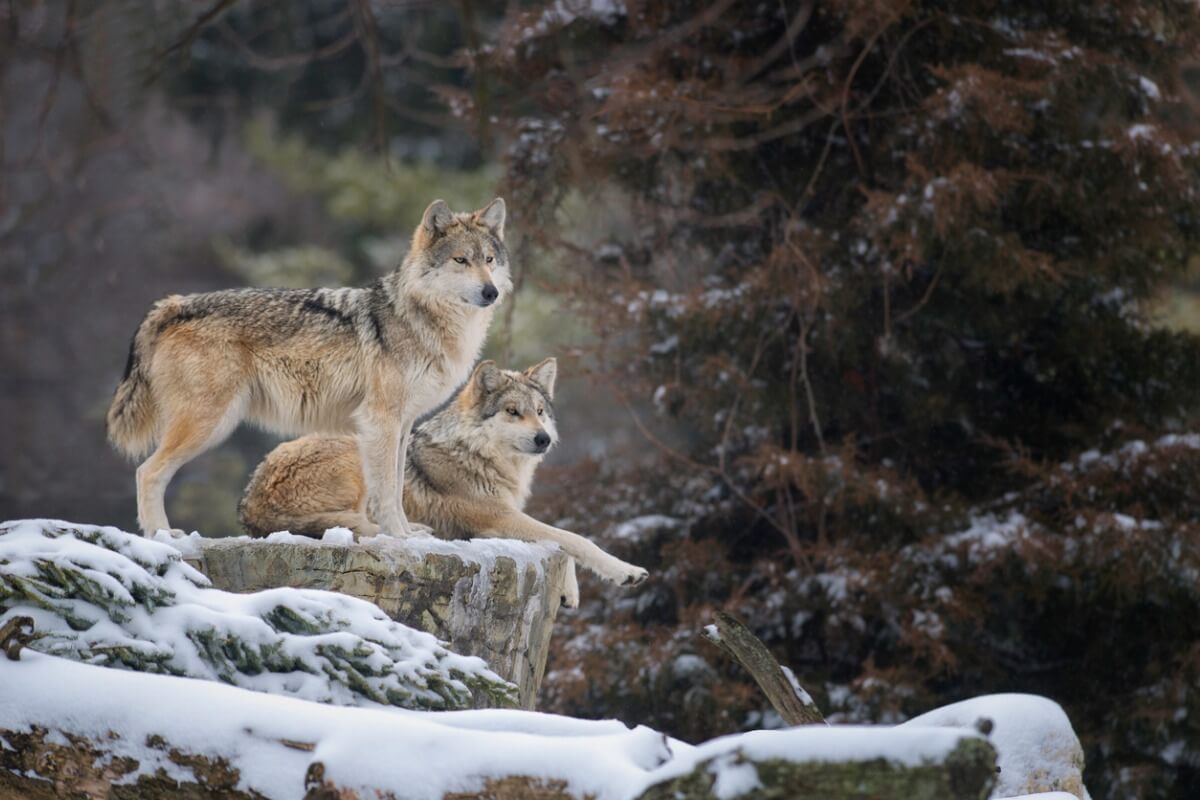Why Is the Mexican Wolf in Danger of Extinction?

Sharing your habitat with predators is complicated, especially for those who own livestock farms. The human-animal conflict is perfectly exemplified in the case of the Mexican wolf, which is in danger of extinction due to human economic interests.
In this article, you’ll learn more about this species of canid, as well as the threats it faces and the conservation efforts that are being carried out to save their populations. Don’t miss learning about this magnificent wolf.
Characteristics of the Mexican wolf
The Mexican wolf (Canis lupus baileyi) is a smaller species of canid than other representatives of the genus Canis. It’s no more than 80 centimeters tall and weighs only about 45 kilograms maximum. Its coat is brownish with light yellowish and greyish tones along its body.
Its range (before the reduction of its population) extended from the Sonoran Desert, Chihuahua and central Mexico to western Texas, southern New Mexico, and central Arizona. The Mexican wolf prefers relatively moist environments, usually temperate forests and grasslands.
Like all wolf subspecies, Canis lupus baileyi is a strict carnivore. Its preferred prey is the white-tailed deer, which packs hunt in groups in perfect coordination. Even so, obtaining large victims is difficult, so these wolves make a point of eating as much as they can in one sitting.
A wolf can fast for 2 weeks until it gets a prey.

The social structure of Mexican wolf packs is hierarchical and is headed by an alpha pair that’s in charge of defending the group. Each population delimits and defends its territory with zeal, patrolling the boundaries and marking them with urine and claw and teeth marks.
Regarding reproduction, the female’s gestation lasts about 65 days and it gives birth to 4 to 7 pups. These are born blind and deaf and depend entirely on the mother during their first weeks of life. The female takes care of them in the den and the father watches over the surroundings.
Why is the Mexican wolf endangered?
The Mexican wolf has been endangered since 1976. At that time, there were fewer than 50 living wolves. Several reasons led to this worrying decline:
- Reduction in the number of prey and loss of habitat due to human occupation of their territories.
- Conflict with humans: Due to the lack of food, Mexican wolves used to go to cattle herds to hunt, so they became the targets of several killings.
- Poisonous traps and bait: Many ranchers used these techniques to get rid of them.
- Use of pesticides on crops: Some of them, such as sodium monofluoroacetate, killed wolves that wandered into human settlements in search of food.
There was a time in the 1950s when the Mexican wolf had been exterminated in the wild. In the seventies, conservation efforts were initiated, as, around this time, the species was included in the list of endangered animals.
Conservation status of the Mexican wolf
Between the seventies and eighties of the twentieth century, the AZA Mexican Wolf SSP Plan for the Survival of the Mexican Wolf was implemented. For this purpose, a captive breeding program was initiated from the few specimens that could be captured in the wild.
This plan aimed to reintroduce specimens in their natural habitat. However, it wasn’t until the first decade of the 21st century that the program bore fruit. These are the most relevant data of the process:
- 2012: At least 75 Mexican wolves and 4 breeding pairs were counted in the areas that were protected for them.
- 2014: First wolf pup born in the wild since the recovery plan began.
- 2015: A population of more than 100 wolves is reported in southwestern New Mexico and southeastern Arizona (USA). This represents a 31% increase in numbers since 2013.
- 2016: Last official count. At this time, 21 wild wolves are reported within Mexico and 15 pups from 3 different litters born in the wild.
- 2017: The first wild-born wolf to survive to reproductive age mates with a female reintroduced from captivity and produces a healthy litter.
Certain organisms noticed the importance of the economy in the conservation of the Mexican wolf, so efforts were invested in spreading awareness and asking for help from the human population. The foundation of environmental education centers and the development of tourism programs were able to bring economic benefits.

These species recovery programs are clear proof that coexistence with wildlife is possible. Little by little, the general population is becoming aware of the work that carnivorous animals do in the ecosystem. These advances in general thinking give hope for all the species that suffer at the hands of humans today.
Sharing your habitat with predators is complicated, especially for those who own livestock farms. The human-animal conflict is perfectly exemplified in the case of the Mexican wolf, which is in danger of extinction due to human economic interests.
In this article, you’ll learn more about this species of canid, as well as the threats it faces and the conservation efforts that are being carried out to save their populations. Don’t miss learning about this magnificent wolf.
Characteristics of the Mexican wolf
The Mexican wolf (Canis lupus baileyi) is a smaller species of canid than other representatives of the genus Canis. It’s no more than 80 centimeters tall and weighs only about 45 kilograms maximum. Its coat is brownish with light yellowish and greyish tones along its body.
Its range (before the reduction of its population) extended from the Sonoran Desert, Chihuahua and central Mexico to western Texas, southern New Mexico, and central Arizona. The Mexican wolf prefers relatively moist environments, usually temperate forests and grasslands.
Like all wolf subspecies, Canis lupus baileyi is a strict carnivore. Its preferred prey is the white-tailed deer, which packs hunt in groups in perfect coordination. Even so, obtaining large victims is difficult, so these wolves make a point of eating as much as they can in one sitting.
A wolf can fast for 2 weeks until it gets a prey.

The social structure of Mexican wolf packs is hierarchical and is headed by an alpha pair that’s in charge of defending the group. Each population delimits and defends its territory with zeal, patrolling the boundaries and marking them with urine and claw and teeth marks.
Regarding reproduction, the female’s gestation lasts about 65 days and it gives birth to 4 to 7 pups. These are born blind and deaf and depend entirely on the mother during their first weeks of life. The female takes care of them in the den and the father watches over the surroundings.
Why is the Mexican wolf endangered?
The Mexican wolf has been endangered since 1976. At that time, there were fewer than 50 living wolves. Several reasons led to this worrying decline:
- Reduction in the number of prey and loss of habitat due to human occupation of their territories.
- Conflict with humans: Due to the lack of food, Mexican wolves used to go to cattle herds to hunt, so they became the targets of several killings.
- Poisonous traps and bait: Many ranchers used these techniques to get rid of them.
- Use of pesticides on crops: Some of them, such as sodium monofluoroacetate, killed wolves that wandered into human settlements in search of food.
There was a time in the 1950s when the Mexican wolf had been exterminated in the wild. In the seventies, conservation efforts were initiated, as, around this time, the species was included in the list of endangered animals.
Conservation status of the Mexican wolf
Between the seventies and eighties of the twentieth century, the AZA Mexican Wolf SSP Plan for the Survival of the Mexican Wolf was implemented. For this purpose, a captive breeding program was initiated from the few specimens that could be captured in the wild.
This plan aimed to reintroduce specimens in their natural habitat. However, it wasn’t until the first decade of the 21st century that the program bore fruit. These are the most relevant data of the process:
- 2012: At least 75 Mexican wolves and 4 breeding pairs were counted in the areas that were protected for them.
- 2014: First wolf pup born in the wild since the recovery plan began.
- 2015: A population of more than 100 wolves is reported in southwestern New Mexico and southeastern Arizona (USA). This represents a 31% increase in numbers since 2013.
- 2016: Last official count. At this time, 21 wild wolves are reported within Mexico and 15 pups from 3 different litters born in the wild.
- 2017: The first wild-born wolf to survive to reproductive age mates with a female reintroduced from captivity and produces a healthy litter.
Certain organisms noticed the importance of the economy in the conservation of the Mexican wolf, so efforts were invested in spreading awareness and asking for help from the human population. The foundation of environmental education centers and the development of tourism programs were able to bring economic benefits.

These species recovery programs are clear proof that coexistence with wildlife is possible. Little by little, the general population is becoming aware of the work that carnivorous animals do in the ecosystem. These advances in general thinking give hope for all the species that suffer at the hands of humans today.
All cited sources were thoroughly reviewed by our team to ensure their quality, reliability, currency, and validity. The bibliography of this article was considered reliable and of academic or scientific accuracy.
- Servín, J. (1997). EL PERIODO DE APAREAMIENTO, NACIMIENTO Y CRECIMIENTO DEL LOBO MEXICANO [CANIS LUPUS BAILEYI). ACTA ZOOLÓGICA MEXICANA (N.S.), (71), 45-56. https://doi.org/10.21829/azm.1997.71711742
- Lobo gris mexicano. (s. f.). Biodiversity Web. Recuperado 28 de septiembre de 2021, de https://www.biologicaldiversity.org/espanol/especies/lobo_gris_mexicano.html
This text is provided for informational purposes only and does not replace consultation with a professional. If in doubt, consult your specialist.








